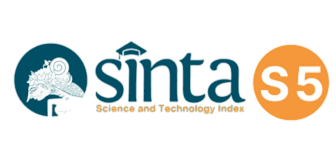Faktor Lingkungan Fisik yang Berhubungan dengan Karakteristik Onchomelania hupensis linduensis Vektor Schistosomiasis di Kecamatan Lindu
Keywords:
Oncomelania hupensis linduensis, schistosomiasis, physical environmentAbstract
Background: Lindu Plateau is surrounded by mountains and protected forests and there is a lake that is the source of community life and habitat for Oncomelania hupensis linduensis (OHL), an intermediate host for schistosomiasis. Purpose: To determine the relationship between environmental temperature, air humidity, turbidity and water pH with density, physical/morphological characteristics and the presence of parasites in OHL snails in active focus areas in Lindu District. Method: Analytical research with an observational survey approach, in Lindu District from May to October 2019. The population was OHL snails in Lindu District, sampled by accidental sampling in 5 research locations, namely Tomado, Langko, Anca, Puroo and Oluu villages. Result: Chi-square test with α=0.05 on environmental temperature and OHL snail density p-value=0.447, ambient temperature and OHL snail external morphology p-value=0.04, temperature and presence of cercariae parasites on OHL snails p -value=0.004; humidity and density of OHL snails p-value=0.193, humidity and external morphology of OHL snails p-value=0.17, humidity and presence of cercariae parasites in OHL snails p-value=0.175; water turbidity and OHL snail density p-value=1,000, water turbidity and OHL snail external morphology of OHL snails p-value=0,070, water turbidity and presence of parasites on OHL snails p-value=0,000; pH of Water and OHL snail density p-value=0,328, pH of water and external morphology of OHL snails p-value=0,017, pH of water with the presence of parasites on OHL snail p-value=0,430. Conclusion: Environmental temperature was related to external morphological characteristics and the presence of parasites in OHL snails, water turbidity related to the presence of parasites in OHL snails, water pH related to external morphological characteristics of OHL in the active focus areas. The government is advised to disseminate information about the active focus areas of OHL snails to prevent schistosomiasis infection in the community.
References
Badan Penelitian dan Pengembangan Kesehatan Kementerian Kesehatan RI. Penyakit Menular Neglected. 2013. 67–88 p.
Mujiyanto, Garjita Ambar Triwobowo, Anastasia Hayani, Udin Yusran KA. Kondisi Iklim dan Mikrohabitat Fisik Daerah Endemis Schistosomiasis di Dataran Tinggi Napu Kabupaten Poso. Pros Semin Nas Geogr UMS [Internet]. 2016;217–27. Available from: https://publikasiilmiah.ums.ac.id/bitstream/handle/11617/8553/21_Mujiyanto.pdf?sequence=1
Rosmini, Jastal, Ningsi. Faktor Risiko Kejadian Schistosomiasis Di Dataran Tinggi Bada Kabupaten Poso Sulawesi Tengah. Vektora J Vektor dan Reserv Penyakit. 2016;8(1):1–6.
Muslimin D. Faktor Risiko Host terhadap Kejadian Schistosomiasis Japonicum. Afiasi J Kesehat Masy. 2018;3(3):93–100.
Garjito TA, Sudomo M, Abdullah, Dahlan M, Nurwidayati A. Schistosomiasis in Indonesia: Past and present. Parasitol Int. 2008 Sep 1;57(3):277–80.
Kementerian Kesehatan Republik Indonesia. Peraturan Menteri Kesehatan. Nomor 82 Tahun 2014 2014.
Nurwidayati A, Frederika PP, Sudomo M. Fluktuasi Schistosomiasis di Daerah Endemis Provinsi Sulawesi Tengah Tahun 2011-2018. Bul Penelit Kesehat. 2019;47(3):199–206.
Hardisman. Metodologi Penelitian Kesehatan. Yogyakarta: Gosyen Publishing; 2021.
Kalinda C, Chimbari M, Mukaratirwa S. Implications of Changing Temperatures on the Growth, Fecundity and Survival of Intermediate Host Snails of Schistosomiasis: A Systematic Review. Int J Environ Res Public Health [Internet]. 2017 Jan 13 [cited 2022 May 10];14(1). Available from: /pmc/articles/PMC5295331/
Hadidjaja P. Schistosomiasis di Sulawesi Tengah. Jakarta: Fakultas Kedokteran Universitas Indonesia; 1986.
Moose JW, Williams JE. Susceptibility of Oncomelania formosana from Three Different Areas of Taiwan to infection with Formosana strain of Schistosoma japonicum. J Parasitol. 1963;49:702–3.
Sulieman Y, Eltayeb RE, Pengsakul T. Some Abiotic Factors Affecting Schistosomiasis Intermediate Hosts: An Overview. Shendi Univ J Appl Sci [Internet]. 2018;2018(1):1–8. Available from: http://repository.ush.sd:8080/jspui/bitstream/123456789/520/1/Some abiotic factors affecting schistosomiasis intermediate hosts.pdf
CDC - Schistosomiasis [Internet]. [cited 2022 May 10]. Available from: https://www.cdc.gov/parasites/schistosomiasis/index.html
Zhang ZY, Xu DZ, Zhou XN, Yun Z, Liu SJ. Remote sensing and spatial statistical analysis to predict the distribution of Oncomelania hupensis in the marshlands of China. Acta Trop. 2005 Nov 1;96(2–3):205–12.
Faust EC, Meleney HE, Annandale N. Studies on Schistosomiasis Japonica. Am J Hyg. 1924;
Calasans TAS, Souza GTR, Melo CM, Madi RR, de Lourdes Sierpe Jeraldo V. Socioenvironmental factors associated with Schistosoma mansoni infection and intermediate hosts in an urban area of northeastern Brazil. PLoS One [Internet]. 2018;13(5):1–14. Available from: https://www.ncbi.nlm.nih.gov/pmc/articles/PMC5931446/pdf/pone.0195519.pdf
Rosmini, Garjito TA, Erlan A, Gunawan. Infection Rate Host Perantara dan Prevalensi Reservoir Schistosoma japonicum di Dataran Tinggi Bada Sulawesi Tengah. J Ekol Kesehat [Internet]. 2014;13(1):43–9. Available from: http://ejournal.litbang.kemkes.go.id/index.php/jek/article/view/3941
Erkano WK. Impacts of Environmental Parameters on the Infectivity of Freshwater Snail. In: Ray S, Mukherjee S, editors. Update on Malacology. IntechOpen; 2022.





